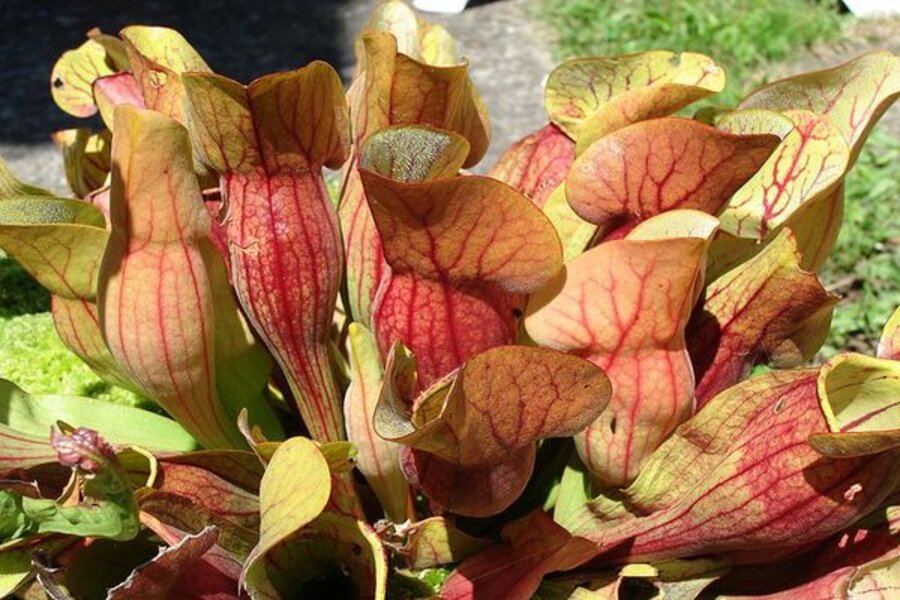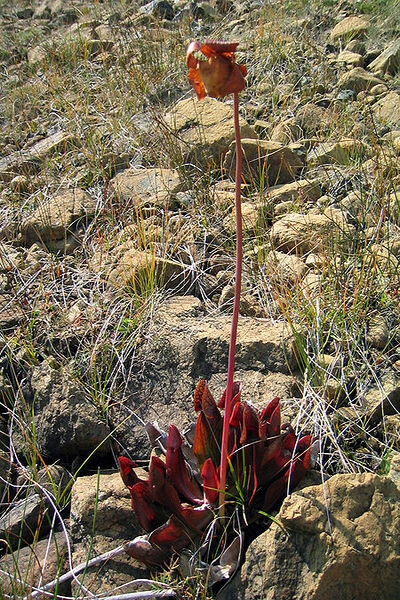Pitcher plants are native, carnivorous, and fun to grow
Loading...
Among meat-eating bog plants, no plant gets as much attention as the Venus fly-trap (Dionaea muscipula). Personally, I don’t know what all the fuss is about.
Maybe it’s the public’s mental image of "The Little House of Horrors" Audrey, Jr.’s menacing monster-mouth leaf clamping shut that is permanently seared on our brains. Or maybe it’s the fascination with the shrewd engineering marvel of its very specialized trapping structure.
Whatever the reason, I’m not impressed. What piques my interest is another carnivore, our beautiful native pitcher plant, Sarracenia purpurea.
A hardy species, native to boggy areas of the United States' Eastern coast and parts of the Midwest, pitcher plants produce a single red, nodding flower atop a thick, leafless stalk. However, it’s the devilishly attractive, flaring pitcher-shaped leaves that are the basis of man’s fascination with the plant.
The unique, greenish to reddish upright leaves of these wickedly striking pitcher plants (or pitfall traps, as they are sometimes called) can be tall and spectral, or short and chunky, but they are all intriguing hooded, hollow tubes with a darker-colored reddish filigreed pattern that gives them a strange reptilian-like quality.
In short, they are wildly – some might even say weirdly – beautiful.
As attractive as they are to humans, they are deliciously seductive to insects. Foraging, crawling, or flying insects -- such as flies, wasps, ants, and similar small prey -- are lured in by the nectar that seeps around the edges of the colored lip. Once the insect has fallen inside the tube, it is trapped to drown in the rainwater collected at the base of the tube.
Enzymes secreted by the plant aid in the digestion of the insect, but much of the breakdown of the decayed pest bodies is passive, a result of bacterial activity. Then the plant absorbs the nutrients as nourishment through special cells located at the base of the pitcher.
So, upon landing, hungry insects find that what they thought was a king-sized ambrosial gourmet spread, is in reality, a cunningly executed death trap of a horticultural eating machine.
Cultural requirements
This is the one kicker. In recent years pitcher plants have become quite popular with gardeners, but for success, strict adherence to the particular cultural needs of these plants is essential.
The kind of “soil” that supports pitcher plants is water logged, nutrient poor, and highly acidic. In fact, good soil, fertilizer, and mineral enriched water are all too rich for these plants.
They thrive in an acidic growing medium, such as a mixture of peat and sand, a sunny spot, and either distilled water or rainwater. And most important, soil is to be kept moist at all times.
My suggestion, if you are interested in growing pitcher plants, is to visit the International Carnivorous Plant Society website for full instructions on the ins and outs of their cultural requirements.
Sarracenia are not hard to cultivate, as long as you follow “The Rules”. If you deviate, you are out of luck.
Responsible purchases
Our responsibility as educated gardeners is not to purchase pitcher plants that may have been illegally harvested in the wild, but rather, buy them from reputable mail-order nurseries, garden centers, and cultivated sources, since vendors who dig up plants in the wild have placed extreme stresses on wild populations.
All purchased pitcher plants should be nursery propagated, either from seed or tissue culture.
-----
Betty Earl, the Intrepid Gardener, blogs regularly at Diggin' It. She's the author of “In Search of Great Plants: The Insider’s Guide to the Best Plants in the Midwest.” She also writes a regular column for Chicagoland Gardening Magazine and The Kankakee Journal and numerous articles for Small Gardens Magazine, American Nurseryman, Nature’s Garden, and Midwest Living Magazine, as well as other national magazines. She is a garden scout for Better Homes and Gardens and a regional representative for The Garden Conservancy. To read more by Betty, click here.






